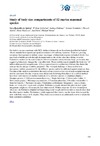Identificador persistente para citar o vincular este elemento:
https://accedacris.ulpgc.es/jspui/handle/10553/71334
| Título: | Study of body size compartments of 12 marine mammal species | Autores/as: | Bernaldo de Quirós Miranda, Yara McLellan, William Fahlman, Andreas Fernández Rodríguez, Antonio Jesús Arbelo Hernández, Manuel Antonio Niemeyer, Misty Pabst, Ann Moore, Michael |
Clasificación UNESCO: | 310907 Patología 3109 Ciencias veterinarias |
Fecha de publicación: | 2016 | Resumen: | Gas bubble lesions consistent with DCS similar to human divers have been described in beaked whales stranded in temporal and spatial association with military exercises. There is a growing consensus that exposure to military sonar may trigger a behavioral response in beaked whales that may lead to bubble growth through decompression as the whales alter their diving behavior. Theoretical studies can be used to model different scenarios and to estimate tissue gas burden, thus suggesting behavioral changes that may affect risk. These models usually simplify the body into “n” independent parallel compartments. A body compartment is a collection of tissues that shares the same perfusion and gas solubility properties. The principal challenge of these models is to incorporate realistic parameters for the different species and to be calibrated against empirical data. The aim of this study is to determine the weigh of each tissue so the size of each compartment can later be calculated. For this purpose, mass dissections following McLellan et al.’s (2002) method have been performed in 21 marine mammals of 12 different species: 4 Delphinus delphis, 1 Grampus griseus, 2 Globicephala macrorhynchus, 1 Kogia breviceps, 1 Mesoplodon bidens, 2 Halichoerus grypus, 1 Mirounga angustirostris, 1 Phocoena phocoena, 3 Stenella coeruleoalba, 1 Stenella frontalis, 1 Tursiops truncatus, 3 Zaplophus californianus. Integument, muscle, bones, brain, and every other organ were weighed. Preliminary results showed that phocids had higher integument weight and lower muscle mass than otariids. Within cetaceans the short-finned pilot whale and the bottlenose dolphin had larger integument weight and lower relative muscle mass than the other species studied. Preliminary results suggested that muscle was the tissue that changed the most with body weight in D. delphis. Thus, body composition is an additionally tool to evaluate the body and health condition. | URI: | https://accedacris.ulpgc.es/handle/10553/71334 | Fuente: | 30th Annual Conference of the European Cetacean Society. Madeira, Portugal, 14-16 March 2016 / Luís Freitas; Cláudia Ribeiro (ed.), p. 256 |
| Colección: | Actas de congresos |
Visitas
42
actualizado el 10-ene-2026
Descargas
13
actualizado el 10-ene-2026
Google ScholarTM
Verifica
Comparte
Exporta metadatos
Los elementos en ULPGC accedaCRIS están protegidos por derechos de autor con todos los derechos reservados, a menos que se indique lo contrario.
